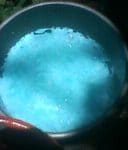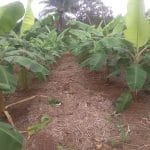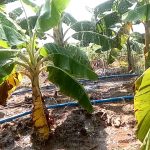By FarmersJoint in Crop and Plantation 
Burgundy mixture is a simple diy copper fungicide that is effective against many fungi diseases in crops. It is a mixture of copper sulfate (CuSO4) and sodium carbonate (sodium bicarbonate, Na2CO3). It is also known as “sal soda Bordeaux”, not to be confused with Bordeaux mixture, which is a mixture of copper sulphate and hydrated lime (Ca(OH)2).
The chemicals listed here can be bought in places where Industrial or Chemistry lab chemicals are sold. But it is cheaper to buy from Industrial chemical sellers. In Anambra State, Nigeria, you can get them from Uga market, close to River Niger Bridge Head.
How to Make Burgundy Mixture
The amount of ingredients to use depends on the percentage of copper sulphate in the mixture. A 1% Burgundy mixture will contain 1% copper sulphate (that is, 1kg copper sulphate in 100 liters of water). Sodium bicarbonate is usually added at a higher
>>>>>> [Read more…] <<<<<<
By FarmersJoint in Crop and Plantation 
This is part 3. If you haven’t read part 1 and 2, read them here: Part 1 and part 2.
Fertilizer and Manure Application:
After planting the suckers, I applied 20:10:10 fertilizer 1 month after planting. Dosage is 30ml per plant. By this time, new, white roots have started growing. I buried the fertilizer in a shallow hole 10-20cm away from the plants, making sure I don’t damage too much roots. Note: I applied Carbofuran (for nematode control) into the same hole with the NPK. More on Carbofuran later under “pesticide application” below.
Second NPK application can be made 2 months after planting, 50cm away from the plant. I used 30ml 20:10:10 per plant but those that were growing fast got 60ml.
About 1 month or so after the second NPK application, I planned applying organic manure at 11L pig manure per plant but I couldn’t get
>>>>>> [Read more…] <<<<<<
By FarmersJoint in Crop and Plantation 
Readers note: This is a continuation of the part 1 series. It is important that you read part 1 before this. Thanks.
Peeled, chemically treated plantain corm. You can see the tunnel I made to reach the weevil inside.
Transporting Suckers:
Suckers are very bulky and transporting them over long distances can be a nightmare. You can reduce transportation cost by cutting the pseudostems in half. The larger the corm sizes, the greater the survival rate. Even if the pseudostem eventually dies, new suckers will emerge from the corm if you leave it for some weeks. Suckers with large corms can be cut off a few centimeters above the corm.
Chemical Treatment of Suckers: After peeling the corms, I wash them and using a knapsack sprayer, I spray a mixture of insecticides, fungicides and foliar fertilizer on the corm. But note, peel the corms outside your
>>>>>> [Read more…] <<<<<<
By FarmersJoint in Crop and Plantation 
I have grown crops like cucumber, pepper and okra and I know how much pesticides they can consume. Growing them large scale can be very expensive. While thinking of a low cost alternative, plantains or banana comes to mind (cassava and cocoyam are also cheaper to grow). I have 10 plots of land (rented) but since the past 3 years, half of it remained empty because I could not afford using it for expensive crops. So I decided to fill the empty plots with plantain and pawpaw. I will be writing about the pawpaw farm in another post.
Spray tube irrigation in my plantain farm Soil Requirements:
Plantain require a deep, well-drained soils that are rich in organic matter. The plants will grow optimally in soil with a pH between 5.5 and 7.0. They need water to yield well. So plant them during the rainy season. If rainy
>>>>>> [Read more…] <<<<<<
By FarmersJoint in Crop and PlantationDo you know that weeds can cause over 50% yield loss? Weed control is very important in every crop farm. The trick is to control weeds until your crops form a canopy that covers the land. This will prevent light from reaching weeds and they won’t grow fast enough to be a problem. The trick is not to totally eliminate weeds – you can’t achieve that in a large farm – but to frustrate their growth to the point where they’ll not cause yield loss.
Manual weeding is time consuming and painfully laborious. It is not practical to weed hectares of farmland by hand. That is why successful farmers are known to use chemical weed control. It is far cheaper than manual or mechanical weed control.
You may be wondering which safe herbicide to use in your cassava farm. Some people have learnt the hard way in the past when
>>>>>> [Read more…] <<<<<<
I have farmed cucumber twice. I started at a very small scale and then scaled up a little. This enabled me to learn the ropes and keep loss to a minimum. My first trial was a near disaster as diseases nearly wipe out everything. Second trial was better as I made a reasonable net profit (1.33 ROI but without including cost of fixed assets like knapsack sprayer, boot etc, ROI was about 2). Below are some of the things I learnt:
Update: For recent info on cucumber farming, read: My Cucumber Farm Journey 2023
1. Humid Condition Attracts Diseases: I planted when the rainy season started. At the peak of rainfall when rain fall almost daily, disease struck. I suspects downy mildew. This disease first appear as yellow spots on the leaves which later turn brown. It expands and kill the whole leaves and the plants soon die.
>>>>>> [Read more…] <<<<<<
Weeding manually is very costly and labor-intensive. But with herbicides, weeding becomes easier. Below are herbicides you can use without killing your soybean crops.
Post Emergence Herbicides:
These are herbicides that kill weeds that have grown out from the soil. You can apply it to kill weeds before you start land preparation. See manufacturer’s label for dosage. Below are 2 post emergence herbicides you can use.
1. Glyphosphate: This is a systemic herbicides – meaning that it enters the weeds’ system and kill them completely. It kills both broadleaf and grass weeds. It will kill soybean but because it has no residual activity in the soil, you can use it before you plant soybean but not after. It acts slowly and takes about 2 weeks to kill weeds.
2. Paraquat: This is a contact herbicide because it kills the part of weed it comes in contact with. It does not
>>>>>> [Read more…] <<<<<<
If you’re looking for an organic and earth-friendly way to control insects in your farm or garden, neem seed extract is a very good choice to consider. It contains azadirachtin, the main active ingredient responsible for its pesticidal effects. Neem seeds come from the neem tree, a popular medicinal tree that originate from India. The tree can grow in Africa and in many other continents.
Some people get discouraged when they spray neem seed extract and nothing happen. They expect to see the insects die in masses within a few hours. But neem seed extract doesn’t work like that. It takes about a week to start seeing the effect.
Neem TreeImage Courtesy of sd-nl.com
How Does Neem seed extract Pesticide Works?
Neem extract will kill only insects that consume it. It is a hormone disruptor. Neem extract contains a lot of active ingredients that can disrupt
>>>>>> [Read more…] <<<<<<
If you have ever tried farming on a plot of land (120x60ft) or more, you’ll agree with me that weeding with hoes is no easy task. It is back- and waist-breaking! If you decide to employ laborers to help you out, they’ll charge you about N7000 per plot (depending on your location). This shows how important it is for you to find ways of cutting weeding cost. And that’s exactly what you’re about to learn.
So how do we go about this? The method we’re going to look at is called the stale seedbed method. Here is how it works. Make your seedbed, ridges or hills (I like working with ridges because it makes operations like fertilizer application or spraying insecticides and fungicides easier). After making your ridges, don’t sow your seeds or transplant yet. Allow about 2 weeks to pass to allow the first flush of weeds to grow.
>>>>>> [Read more…] <<<<<<
By FarmersJoint in Crop and Plantation 
Pepper belongs to the Solanacea family. Other members of this family includes tomato, tobacco, eggplant and Irish potato. There are different varieties of pepper available to choose from. You just have to go to the pepper sellers in your area and find out the variety that sales well. Then visit a state ministry of Agric. and find out where you can buy the seeds. Some people who sell agro-chemicals in markets may also sell seeds.
Is there money to be made in pepper farming? Yes. Pepper mature in 3-4 months and with proper maintenance, you can harvest it continually for 6 months or more. You’ll make much more money if you have access to irrigation facilities so you can irrigate your plants during the dry season. This can either be in the form of borehole or stream/river. In most places in Nigeria, you can easily rent farmlands that are close
>>>>>> [Read more…] <<<<<<
|
Join the Forum Do you want to discover more great info like these?
Register for free and ask your question in our farming forum! Our knowledgeable members will have your questions answered.
FarmersJoint.com strives to maintain accurate and up-to-date information; however, mistakes do happen and we won't be held accountable for anything that result from the use of information provided in this site. If you would like to correct or update any of the information, please send us an e-mail. THANK YOU!
|




